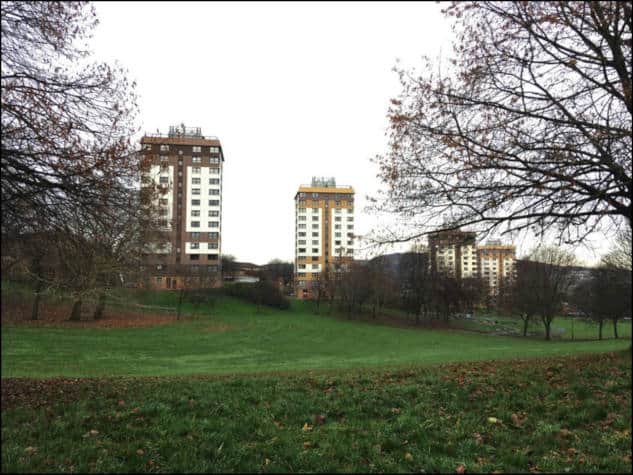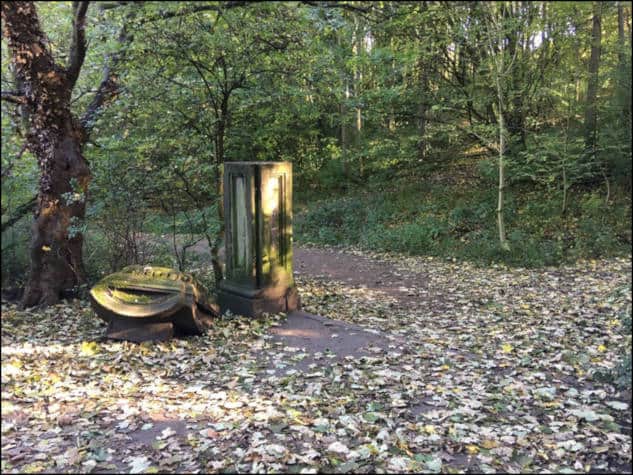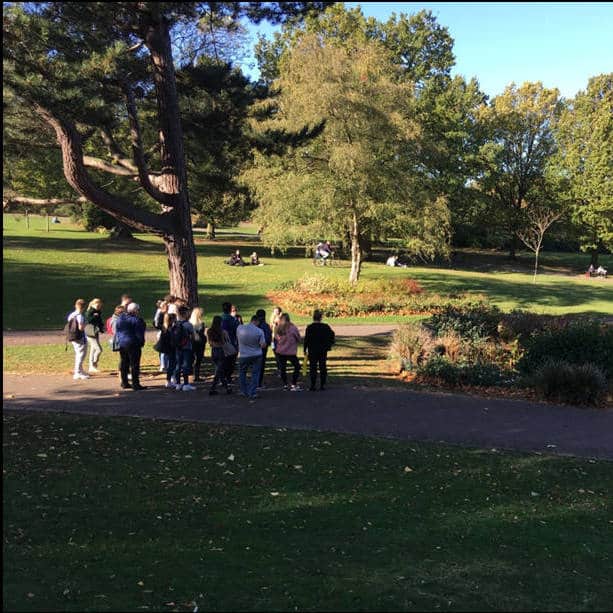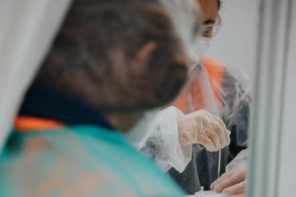A warm lunchtime in Sheffield, a city of half a million people in the north of England. It is late October and unseasonably sunny. In Weston Park, a Victorian park adjoining the University of Sheffield and a cluster of hospitals, a gaggle of students listen to a talk. A woman walks briskly to an appointment. Couples spread themselves on the grass to soak up the sunshine. A small child stamps to scare away the feral pigeons his mother has been feeding for his entertainment.
A short walk away, out of one set of wrought-iron gates and in through another, is Crookes Valley Park. Gathered in the formal lake in the centre of the park is a group of kayakers. Beside a bench a middle-aged man fixes his bike. In the children’s playground a Muslim woman in full veil pushes a toddler on a swing.
Across a main road and downhill is the Ponderosa: a park that was never meant to be a park because it was originally intended for housing. Its accidental nature is reflected in its name: a nickname adopted by local children after a ranch in a 1960s TV programme.
A horseshoe of woodland at the top descends to a flat area of featureless grass surrounded by tower blocks, and to one side is a small orchard planted many years ago by local environmental volunteers.
Today there are fewer people. Rubbish in the woods shows where visitors have passed, an elderly white woman walks a small white dog, and a smattering of Chinese students saunter towards the university campus.
Descending through these three parks is a journey through Sheffield’s socioeconomic tiers: Weston Park, proudly displaying its Green Flag award for excellence. Crookes Valley, overlooked by substantial Victorian villas, many of them now divided into student accommodation. And the Ponderosa, surrounded by housing for people on low incomes in one of the poorer neighbourhoods, under-appreciated and vulnerable.

Photo by Julian Dobson
Revisiting the Ponderosa in early December, on a bright but cold weekday, raises the question of what kind of public space has no public – or what kind of public avoids public spaces. A woman, wrapped head to toe against the cold, wheels her child hurriedly across the green. The children’s play area, the sheltered spaces under the trees, and the football pitch with its rusting metal goalposts are deserted. On a nearby church a sign reads: ‘All accessible lead has been replaced with non-lead materials’. Even the scrap metal dealers have no reason to be here.
Behind the church is a small area of asphalt and grass, a few blue-painted benches to one side, reminiscent of South Yorkshire poet Gav Roberts’ description of ‘perfunctory parks for the oppressed’. But in Roberts’ poem, the oppressed find their own forms of play. Here everyone is inside.
Whose green, then, is the green of public space?
The formal plantings, ornamental trees and duck pond of Weston Park fit a traditional municipal model of public parks, and the public – students, hospital staff and visitors, local residents – appear to love it. Paths are lined with memorial benches, including one describing Weston Park as a couple’s ‘favourite Sunday morning place’. Crookes Valley Park, formal, too, with a wooded border, attracts a steady flow regular and casual visitors. But the Ponderosa? Whose green might that be, and at what times?
Insiders, outsiders
Sheffield Council is doing its best to ensure the Ponderosa has something for everyone. In the autumn it put its plans for improvements out to consultation, and posters and flyers encouraged local residents to have their say. But consultations can never tell the full story.
Stay long enough in the wooded edges of the Ponderosa and you’ll see other forms of belonging. This is a territory for blackbirds, robins, the occasional kestrel; home to assorted rodents; the haunt of foxes, definitely, and possibly badgers and hedgehogs. In a world facing threats of climate change and a ‘sixth great extinction’ of living species, these unnoticed users matter. They matter not only in and of themselves, but because even in neglected green spaces, there are humans who find in them new connections and relief from the stresses of urban life.
People who are lonely, depressed or isolated can find solace in the natural world. Frequently this is in marginal and incidental spaces that echo their own marginality.
The curious amalgams that create a city foreground questions both of the physical inside and outside, and social and economic insiders and outsiders. They force us to ask what constitutes ‘nature’ in an urban context, and what it will become. The urban ecologist Marina Alberti (2016) describes cities as ‘coupled human-natural systems’. But the value to humans of the more-than-human world is mediated through practices and rhetoric that legitimise or delegitimise the spaces where such interrelationships occur, and the activities that might best support connections with the more-than-human. The grounds of a former school, for instance, are valued and used differently when viewed as a habitat for biodiversity than when viewed as a development site for residential housing.

Photo by Julian Dobson
Improving Wellbeing through Urban Nature (IWUN) is a three-year research project based in Sheffield which seeks to explore the connections and practices linking human mental health and the natural environment. Our findings both go beyond and disturb the simple ‘green is good for you’ mantra. Yes, we have found improvements in wellbeing as a direct result of noticing the natural world. But our research has also revealed the kaleidoscope of connections that go well beyond what is often on offer in a municipal park.
Our findings have highlighted, too, that green is not always good for you: places designed for relaxation and restoration can become landscapes of fear and anxiety.
All it takes is some vandalised play equipment, uncleared dog faeces or needles, or kids on motorbikes. The kids on motorbikes, though, are finding their own connections with the natural world even while they are perceived as damaging it.
So while the ’natural’ is mediated through humanly constructed facilities and activities – and a municipal park is nature contained and controlled for human consumption – there is also strong evidence of human desires to be part of a wider world beyond human management, often discovered in ‘urban interstices’ – a ‘reservoir of meanings, which may be constantly elaborated and explored’ (Jorgensen & Tylecote, 2007).
Legitimising and delegitimising discourses
Urban spaces are where the ‘reciprocal interactions between ecological and evolutionary processes’ (Alberti, 2016) become immediate, situated and personal. As IWUN is revealing, these everyday interactions are supported or frustrated through different framings of their value and priority.
Discourses that legitimise green spaces as places of value tend to focus on attributes of aesthetics, wellbeing and social cohesion.
Part of our research involved asking health, planning, greenspace and community practitioners what kind of interventions would best support mental wellbeing. Our research included stakeholder events, a questionnaire, focus groups and individual interviews; 122 individuals took part. Some of the responses were expected, supporting familiar conceptions of the role and value of green spaces. For example, participants described activities in green environments as ways of building confidence and self-esteem, providing routes to recovery from mental illness or trauma:
People who come to our service are often very isolated, they have lost their skill in socialising, not really much going on in their lives, so coming helps people to work alongside other people in a way where they don’t actually have to engage socially until they rebuild confidence, it’s a way that people can actually do some activity and build up their self-esteem… (Head of gardening project)
More generally, providing facilities that encourage the public to use green spaces was seen as a way of benefiting society at large, both through socialisation and through reinvestment of time and energy in the maintenance of natural spaces:
It’s a virtuous circle – you’ve got a nice cafe and loos so people come and they spend longer, so there’s more revenue and more interest in doing stuff, more people join Friends groups… (Public health official)

Photo by Julian Dobson
Such rhetoric serves to valorise the ‘natural’ by emphasising its supporting qualities for human wellbeing. They legitimise investment by stressing desirable qualities – aesthetic pleasure, increased confidence, economic activity and civic engagement. However, participants also engaged in discourses – or reported discourses that they encountered – that devalued and delegitimised investment in ‘natural’ spaces. Even enthusiasts for green spaces, for example, reported that residents in some neighbourhoods did not value them and used them as dumping grounds:
We’ve been clearing sites up in Gleadless woodland, ancient woodland, and as we’ve been cleaning it, they’ve been throwing the rubbish out of the flats. (Parks officer)
Others commented that evidence of the benefits of natural spaces was insufficient or not politically acceptable:
You can put a really strong case together and it’s stacked up in terms of international evidence but if it’s not politically the thing that is acceptable, it doesn’t happen. (Health academic)
Discourses of political acceptability ultimately concern the choices of public bodies and the values attached to those choices. By rationalising problems in particular terms, actors choose whose values they will adopt or recognise whose values hold sway.
In a climate of financial austerity imposed in line with a neoliberal agenda that places higher values on the role of markets and adheres to a ’small state’ ethos, the role of public services is deemed to be one of dealing with emergencies where the market cannot respond – and the state of natural spaces is not yet regarded as an emergency.
The clinching argument that legitimises or delegitimises the spaces within which humans meet the more-than-human is most frequently expressed in terms of cost and investment priorities. Clear hierarchies of action and expertise emerge, as this exchange between two local authority planners in a focus group discussion indicate:
Ethan: It’s the economy so it’s, let’s get it going and everything else can come second, and it really tries to come second because there isn’t space for third…
Finn: Often the green stuff is in the third category, just either doesn’t happen or it’s so watered down that it’s meaningless.
Such discourses not only marginalise care and investment in green and natural spaces, but limit what does occur.
In a self-reinforcing cycle, the concept of a good green space is framed around popularity and footfall. While this supports some human connections with the natural world, it also sidelines the spaces and activities that are perceived as less conventional or less legitimate.
So ‘whose green’ is it?
What emerges in the historical moment of neoliberal austerity and in the situated practice of ‘street level bureaucrats’ – the administrators and officials whose job it is to make sense of public policy and local pressures – is a more or less orderly retreat from engagement with the natural environment.
Where previous human/more-than-human relationships might have been characterised as exploitative (to serve the needs of capital) or controlling (to serve the needs of bureaucracy), discourses of green spaces – or particular activities or facilities in those spaces – as ‘nice to have’ or unaffordable signal a process of disengagement.
For public organisations seeking to survive in a climate of austerity, the answer to the question ‘whose green?’ may ultimately be ‘anyone’s but ours’. And yet for the most vulnerable members of the public whose access to restorative and relaxing environments may depend on long term care for green spaces, an austerity climate produces the response, ‘Not ours either’. At its worst this can lead to a state of ‘nobody’s green’, spaces that are neglected and unused, where the relationship between humans and the more-than-human world is minimised because humans have lost the capacity to manage them and no longer perceive them as safe.
Another answer, and one that may already be observed, is ‘green for some’. In this case the ‘some’ are not only the better-off, although they are usually included. They are those who, by virtue of pre-existing engagement with the natural world, means of access, and resources of time and energy, choose to visit green spaces and participate in their care and maintenance. Those who might struggle in green spaces because of a lack of confidence, mental illness, physical disability, or because they need care and support are more likely to remain excluded.
Where engagement by the public and by public bodies declines, the consequence for the more-than-human world is not one of ‘rewilding’ but a different set of human/more-than-human relationships: green spaces used as dumps and as refuges for those deemed antisocial or undesirable.
But such people need and value natural spaces as much as family picnic parties do; rats and mice are as ‘natural’ as squirrels and robins.
The human and more-than-human continue to co-evolve, but their entanglements and trajectories may become less predictable. Whatever the complexities of these relationships, they call for attention — and attention, in times of urban austerity, tends to be an early casualty.
References
Alberti, M. 2016. Cities that think like planets: Complexity, resilience, and innovation in hybrid ecosystems. Seattle, WA: University of Washington Press.
Jorgensen, A ., & Tylecote, M. (2007) Ambivalent landscapes – wilderness in the urban interstices. Landscape Research 32(4): 443–462.









